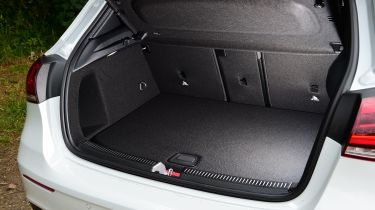Mercedes A-Class hybrid boot space & seating
The Mercedes A-Class hybrid sacrifices some boot space to batteries, but it’s still a fairly practical saloon
| Length | Width | Height | Boot volume (seats up/down) |
|---|---|---|---|
| 4,419mm | 1,992mm | 1,440mm | 345/1,125 litres |
It’s not the most practical plug-in hybrid at this price, but the A-Class remains a well packaged saloon (the hatchback was dropped with the facelift in 2023) despite the addition of some space-robbing batteries. Passenger space is unchanged from the petrol and diesel versions and is competitive with the likes of the BMW 1 Series and Volkswagen Golf – though remember, those are both hatchbacks, not saloons. The Audi A3 is probably the Merc's closest rival, but the saloon version of that car doesn't come as a PHEV.
Elsewhere, headroom is good, but there’s not quite as much legroom as you’ll find in the back the BMW or VW – again, because the Mercedes is now saloon-only. Middle-seat passengers won’t be too comfortable thanks to the bench's raised profile, either.
Mercedes A-Class hybrid interior space, storage & comfort
Front-seat passengers will be the most comfortable; Mercedes rarely disappoints when it comes to making good seats. The driving position is good, too, and there’s lots of useful storage space for bits and bobs, including door pockets big enough for a large bottle of water and a covered centre-console cubby for your phone. In addition, front-seat passengers get an armrest that places the driver’s arm in a perfect position to use the MBUX infotainment system’s centrally mounted controller.
Boot space
Due to those batteries taking up space under the boot floor, the A 250 e loses out slightly to its non-hybrid siblings on luggage capacity. A standard A-Class saloon has 405 litres of boot space with the seats up or 1,210 with them folded down; the A 250 e’s measurements drop to 345 and 1,125 litres respectively. It’s not a deal-breaker – the boot is still of a usable size and shape – but it’s worth considering if load space is important to you. A 40:20:40 split for the rear seats improves versatility and means you can carry two rear passengers while still making room for longer items like skis, flat-pack furniture or wood from the hardware shop.




